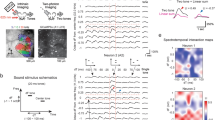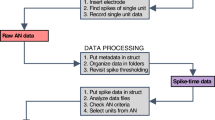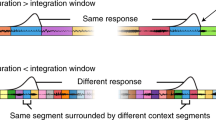Abstract
Analysis of the temporal structure of acoustic signals is important for the communication and survival of a variety of animals including humans. Recognition and discrimination of particular temporal patterns in sounds may involve integration of auditory information presented over hundreds of milliseconds or seconds. Here we show neural evidence for long-term integration in the anuran auditory system. The responses of one class of auditory neurons in the torus semicircularis (auditory midbrain) of frogs reflect the integration of information, gathered over approximately 45–150 ms, from a series of stimulus pulses, not stimulus energy. This integration process is fundamental to the selective responses of these neurons for particular call types.
This is a preview of subscription content, access via your institution
Access options
Subscribe to this journal
Receive 12 print issues and online access
$259.00 per year
only $21.58 per issue
Buy this article
- Purchase on SpringerLink
- Instant access to full article PDF
Prices may be subject to local taxes which are calculated during checkout



Similar content being viewed by others
References
Olive, J. P., Greenwood, A. & Coleman, J. Acoustics of American English Speech. A Dynamic Approach(Springer, New York, 1993).
Moss, C. F. & Schnitzler, H. U. in Hearing by Bats (eds Popper, A. N. & Fay, R. R.) 87–145 (Springer, New York, 1995).
Konishi, M. Birdsong: from behavior to neuron. Annu. Rev. Neurosci. 8, 125–170 (1985).
Gerhardt, H. C. in The Evolution of the Amphibian Auditory System (eds Fritzsch, B. Ryan, M. J., Wilczynski, W., Hetherington, T. E. & Walkowiak, W.) 455–484 (Wiley, New York, 1988).
Huber, F. & Thorson, J. Cricket auditory communication. Sci. Amer. 253, 60–68 (1985).
Bullock, T. H. Some principles in the brain analysis of important signals: mapping and stimulus recognition. Brain Behav. Evol. 28, 145– 156 (1986).
Piheiro, A. D., Wu, M. & Jen, P. H. S. S. Encoding repetition rate and duration in the inferior colliculus of the big brown bat Eptesicus fuscus. J. Comp. Physiol. 169, 69–85 (1991).
Gooler, D. M. & Feng, A. S. Temporal coding in the frog midbrain: The influence of duration and rise-fall time on the processing of complex amplitude-modulated stimuli. J. Neurophysiol. 67, 1–22 (1992).
Casseday, J. H., Ehrlich, D. & Covey, E. Neural tuning for sound duration: role of inhibitory mechanisms in the inferior colliculus. Science 264, 847–850 (1994).
Margoliash, D. Acoustic parameters underlying the responses of song-specific neurons in the white-crowned sparrow. J. Neurosci. 3, 1039 –1057 (1983).
Doupe, A. J. & Konishi, M. Song-selectivity in auditory circuits in the vocal control system of the zebra finch. Proc. Natl. Acad. Sci. USA 88, 11339–11343 (1991).
Margoliash, D. & Fortune, E. S. Temporal and harmonic combination-sensitive neurons in the zebra finch. J. Neurosci. 12, 4309–4326 (1992).
Lewicki, M. S. & Konishi, M. Mechanisms underlying the sensitivity of songbird forebrain neurons to temporal order. Proc. Natl. Acad. Sci. USA 92, 5582– 5586 (1995).
Lewicki, M. S. Intracellular characterization of song-specific neurons in the zebra finch auditory forebrain. J. Neurosci. 16, 5854 –5863 (1996).
Doupe, A. J. Song- and order-selective neurons in the songbird anterior forebrain and their emergence during vocal development. J. Neurosci. 17 , 1147–1167 (1997).
Suga, N., O'Neill, W. E. & Manabe, T. Cortical neurons sensitive to combinations of information-bearing elements of biosonar signals in the mustache bat. Science 200, 778–781 (1978).
Suga, N. Principles of auditory information-processing derived from neuroethology. J. Exp. Biol. 146, 277–286 (1989).
Brenowitz, E. A. & Rose, G. J. Behavioural plasticity mediates aggression in choruses of the Pacific treefrog. Anim. Behav. 47, 633–641 (1994).
Rose, G. J. & Brenowitz, E. A. Plasticity of aggressive thresholds in Hyla regilla: discrete accommodation to encounter calls. Anim. Behav. 53 353–361(1997).
Rose, G. & Capranica, R. R. Temporal selectivity in the central auditory system of the leopard frog. Science 219,1087–1089 (1983).
Walkowiak, W. in Evolution of the Amphibian Auditory System (eds Fritszch, B. Wilczynski, W., Ryan, M. J. & Walkowiak, W.) 275–294 (Wiley, New York, 1988).
Rose G. J. & Capranica, R. R. Processing amplitude-modulated sounds by the auditory midbrain of two species of toads: matched temporal filters. J. Comp. Physiol. 154, 211– 219 (1984).
Rose, G. J., Brenowitz, E. A. & Capranica, R. R. Species specificity and temperature dependency of temporal processing by the auditory midbrain of two species of treefrogs. J. Comp. Physiol. 157, 763–769 (1985).
Klump, G. M. & Gerhardt, H. C. Use of non-arbitrary acoustic criteria in mate choice by female gray tree frogs. Nature 326, 286–288 (1987).
Viemeister, N. F. & Wakefield G. H. Temporal integration and multiple looks. J. Acoust. Soc. Am. 90, 858–865 (1991).
Green, D. M. & Swets, J. A. Signal Detection Theory and Psychophysics (Wiley, New York, 1966).
Lee, J. Amplitude modulation rate discrimination with sinusoidal carriers. J. Acoust. Soc. Am. 96, 2140–2147 (1994).
Wollberg, Z. & Newman, J. D. Auditory cortex of squirrel monkey: response patterns of single cells to species-specific vocalizations. Science 175, 212–214 (1972).
Wang, X., Merzenich, M. M., Beitel, R. & Schreiner, C. E. Representation of a species-specific vocalization in the primary auditory cortex of the common marmoset: temporal and spectral characteristics. J. Neurophysiol. 74, 2685–2706 (1995).
Rauschecker, J. P. Processing of complex sounds in the auditory cortex of cat, monkey, and man . Acta Otolaryngol. Suppl. (Stockh.) 532, 34–38 (1997).
Acknowledgements
This work was supported by a grant from the National Organization for Hearing Research to G.J.R. We thank J. Canfield, E. Fortune and D. Carrier for critically reading this manuscript.
Author information
Authors and Affiliations
Corresponding author
Rights and permissions
About this article
Cite this article
Alder, T., Rose, G. Long-term temporal integration in the anuran auditory system. Nat Neurosci 1, 519–523 (1998). https://doi.org/10.1038/2237
Received:
Accepted:
Issue date:
DOI: https://doi.org/10.1038/2237
This article is cited by
-
Distinct nonlinear spectrotemporal integration in primary and secondary auditory cortices
Scientific Reports (2023)
-
Frog embryos use multiple levels of temporal pattern in risk assessment for vibration-cued escape hatching
Animal Cognition (2022)
-
Acoustic ranging in poison frogs—it is not about signal amplitude alone
Behavioral Ecology and Sociobiology (2017)
-
Species-specificity of temporal processing in the auditory midbrain of gray treefrogs: interval-counting neurons
Journal of Comparative Physiology A (2015)
-
Dip listening or modulation masking? Call recognition by green treefrogs (Hyla cinerea) in temporally fluctuating noise
Journal of Comparative Physiology A (2012)



